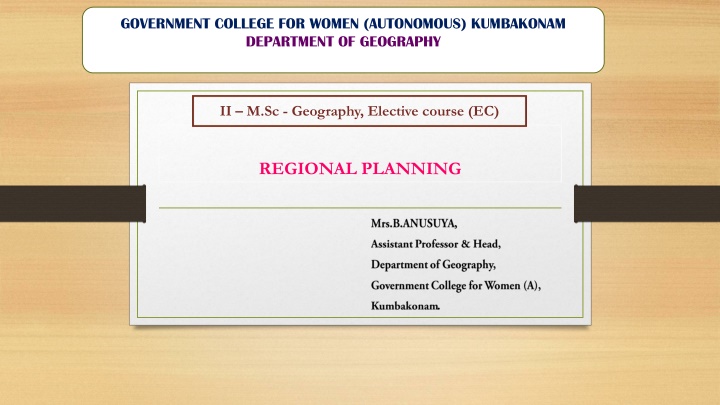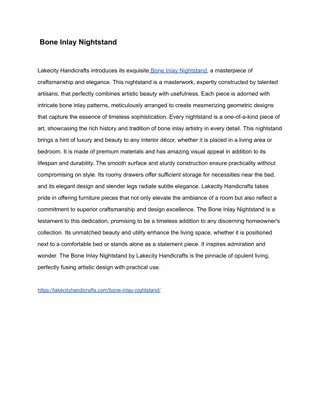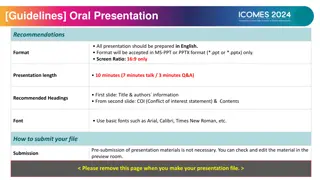
Tribal Area Development Programme: Understanding Indian Tribes and Culture
Explore the Tribal Area Development Programme focusing on the indigenous tribes of India, their cultural significance, and geographical distribution. Learn about the definition of tribes, the diversity among them, and their representation in the Indian Constitution as Scheduled Tribes. Discover the unique characteristics and lifestyle of various Indian tribes like Gonds, Bhils, Santhals, and more. Gain insights into the rich heritage and population distribution of tribal communities across different regions of India.
Download Presentation

Please find below an Image/Link to download the presentation.
The content on the website is provided AS IS for your information and personal use only. It may not be sold, licensed, or shared on other websites without obtaining consent from the author. If you encounter any issues during the download, it is possible that the publisher has removed the file from their server.
You are allowed to download the files provided on this website for personal or commercial use, subject to the condition that they are used lawfully. All files are the property of their respective owners.
The content on the website is provided AS IS for your information and personal use only. It may not be sold, licensed, or shared on other websites without obtaining consent from the author.
E N D
Presentation Transcript
GOVERNMENT COLLEGE FOR WOMEN (AUTONOMOUS) KUMBAKONAM DEPARTMENT OF GEOGRAPHY II M.Sc - Geography, Elective course (EC) REGIONAL PLANNING
UNIT: III UNIT: III TRIBAL AREA DEVELOPMENT PROGRAMME TRIBAL AREA DEVELOPMENT PROGRAMME Introduction: The term Tribal is usually to the aboriginal Population of India not a derogatory sense but an indication of their being the earlist among the the present inhabits of this country. Not all of them are in the same state of culture and cvilization or speak same language or not racially homogeneous. They differ in this respects in a very marked manner.
Meaning of TRIBE: The various authorities have described the Tribal Population by giving different names. They have been described by Risely as 'Aborigioanls'. Dr.Hutton calls their 'Primitive Tribes'. Sir Baines refers tem Hill Tribes . According to the shonaber, they are the Aboriginee still dwelling in primitive stage of civilization.
Definition of TRIBES: a social division in a traditional society consisting of families or communities linked by social, economic, religious, or blood ties, with a common culture and dialect, typically having a recognized leader: "indigenous Indian tribes" In the popular imagination, tribes reflect a way of life that predates, and is more natural than that in modern states. Tribes can also refer to primordial social groups that are clearly bounded, homogeneous, parochial, and stable. Tribes are an organization among families (including clans and lineages)
The Indigenous Colour of India The Indian Tribes Gonds Tribes. Bhils Tribes. Santhal Tribes. Great Andamanese Tribes. Khasi Tribes. Garo Tribes. Angami Tribes. Munda Tribes. Bhutia Tribes. Chenchu Tribes.
How many tribes are there in India? Tribes in India Constitution of India has recognized tribal communities in India under Schedule 5 of the constitution. Hence the tribes recognized by the Constitution are known as Scheduled Tribes . There are around 645 distinct tribes in India. Where are the Indian tribes located? The lively tableau of the tribal community in India stretches from the remote villages tucked in the Indian Himalayan region to southern most tip of India and from the farthest corner of North East India to the dunes of Rajasthan. The tribal population in India covers approximately 15% of the country and the majority is found in central India.
Ecological Aspects: The adivasis of India are as the hills. They are very simple living in the midst of the vast wild and magnificient forest. Wherever the Adirasis or Tribal People reside the regions are still inaccessibile of totally isolated from the civilized human society. The isolation and the acute dpendence upon their physical environment have shaped and moulated them into orthodox fatilistic practices of staunch believess in some unknow mysterious divine power which allow guards, them leads to wherever if chooses.
Occupational Structure: The adirasis of India are the most backward even at present their existence depends to a large extent upon hunting of wild besat and thegathering of wild fruit and berries. Geographic Distribution of Tribes in India: Broadly speaking they may be devided into them groups according to their geographical distribution namely: 1. Tribes of North Eastern Region 2. Tribes of Central Belt of India. 3. Tribes of South and Western and Wertern India.
Problems related with Tribal Area: The basic problems of the Tribal Areas are: 1) Low standared of Living 2) Hunger3)Starvation 4) Mal-Nutrition 5) Illiteracy 6) Disease Prone 7) Poor sanitation 8) Housing facilities. These problems are common to not tribal people special problem is that they have been exploitted by money lenders, forest, contractors, traders, land lords, officials and politicians for a long time.
Developmental Programmes: To elimiminate the above problems Govrenment of India introduce special programmes for the oplift tribal development blocks are established. The success of this programmes are the result of Co- operation and participation of the Tribal People. During the second Five Year Plan (40 multi purpose pilot projects) were introduced for the development of the Tribal People. In the Pilot Projects, all aspects of Tribal life were taken for development. (Ex) Encouragement of settled agriculture, provition of medical facilities, improvement of communication system, development of arts and crafts, commnity welfare centres and so on.
Besides these various programmes have been started by the central and state Governments for the development of the tribas. Some of the programmes ars as follows, Central Govrenmental Sponserved Programme: 1. Tribal Developmental Blocks 2. Research Training and Special Projects 3. Coaching cum guidance centre 4. Scholarships and 5. Girls hostel etc.,
Programme Sponsored by State Government: 1. Scholarships 2. Provision of Education equipments 3. Setting up of Ashram School 4. Hostels 5. Provision of Land and Irrigation 6. Development of Cottage Industries 7. Medical facilities 8. Provision of House sites and House 9. Legal Advice etc.,
Further Tribal development agency projects were established in 1971-72 in Andhra Pradesh, Orissa, Madhya Pradesh & Bihar. The aim of these projects were to develop the selected Tribal Areas in a comprehensive manner. The District Collector is the Chairman and the agency has a full time project officer. Government sincerely attempted to develop the Tribal communities by various programmes by these the Tribes have come losed to other community yet, there are some darwbacks are:
1. The Impact of the Education Programme of the Government programmes has been uneven. Only few students got schlorships, some states got scholarships than others some advanced schedules Tribes gained educational benefits out of all tribes while other tribes failed to get scholarships. Schedule tribes are not given their resevation seats in Educational Instition. Ex Muslim Aligher University There are numbers of humilation hrasment and ill treatment transfors and other officials matters.
2. The Tribal Development Blocks failed to achieve their aims. The benefits failed to raech the lower strata of the society. These programme has been carried of without the participation of the Tribal People. 3. The Politicians, Administratres and local leaders exploit the benefits of the Development programme. 4. Establishment of Industries in Tribal Araes drive them away from thei own land example. Iron and steel plant in Bihar. 5. The fund allocated Tribal Development is inadequate. 6. In some states there are not state level officers for Tribal Development Programme. (T.D.P)
There are 4 aspects in Integrated development Programmes are: 1. Spectoral come trmporal Intrgration 2. Spatial Integration 3. Integration between the development of diffrent people in groups of people. & 4. ntegration of the conficting goals of economic, social and environmental development.






















